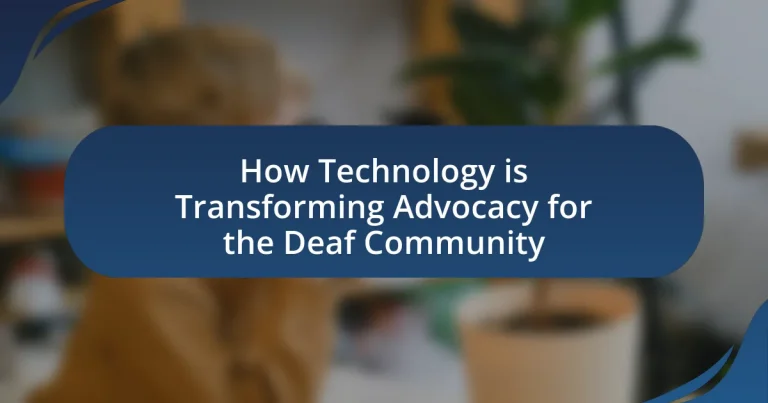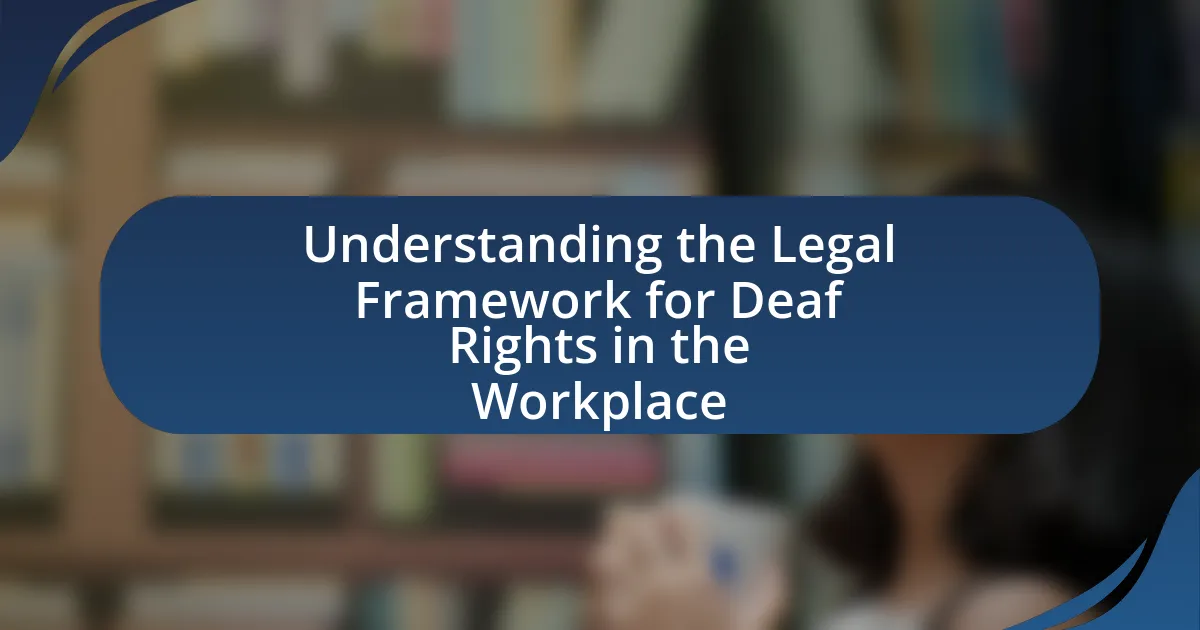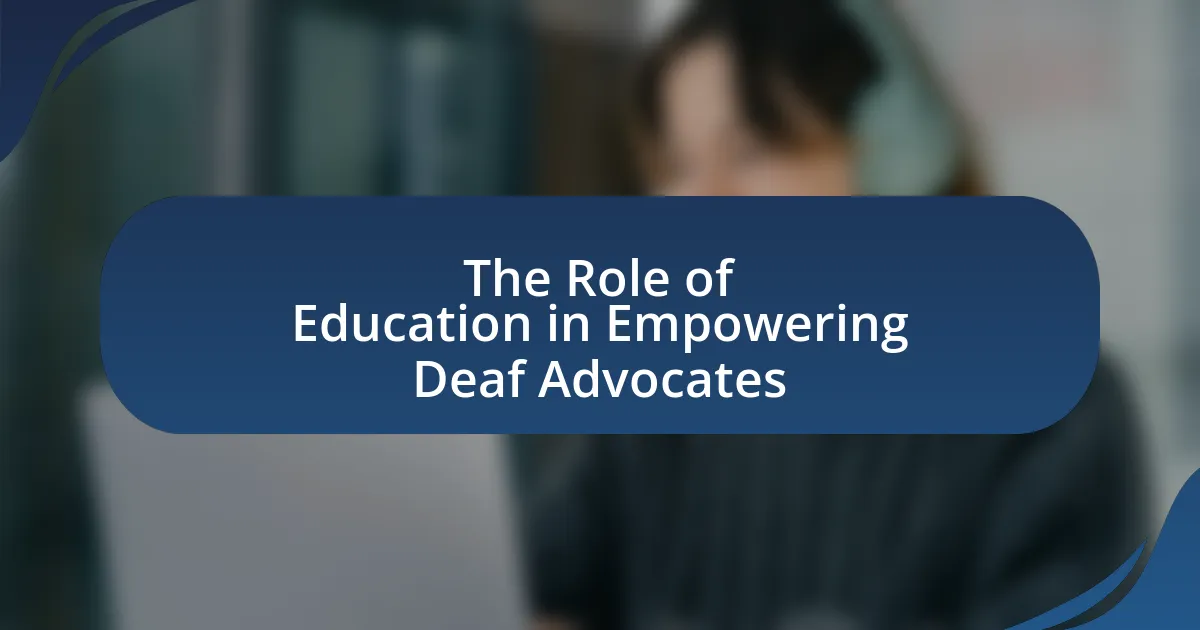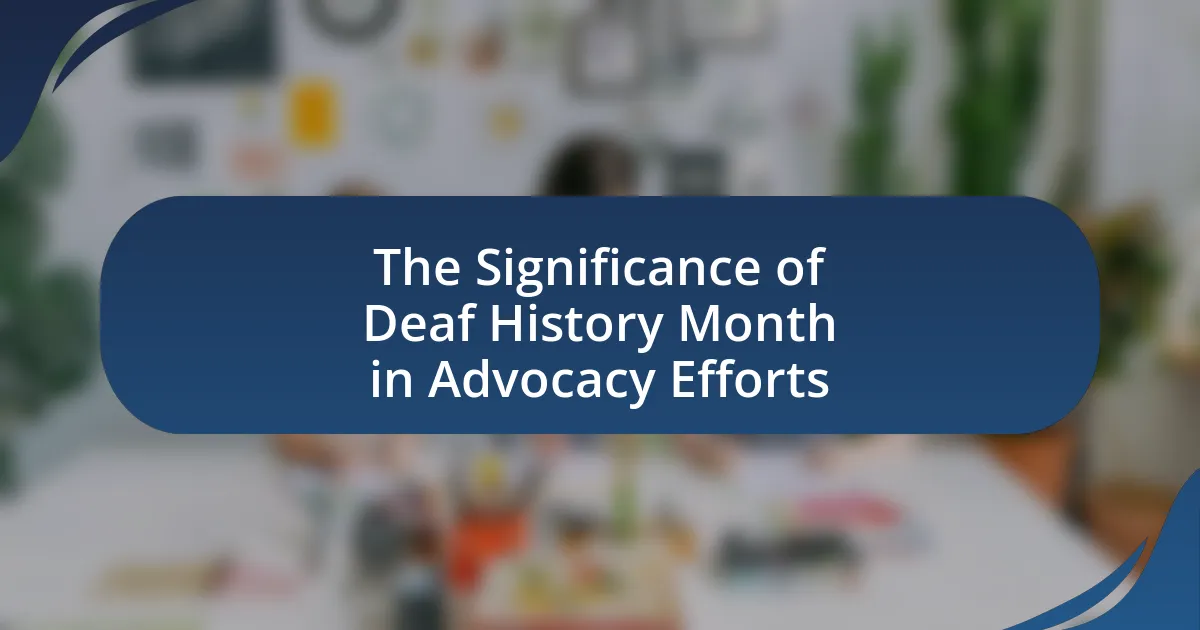The article focuses on how technology is transforming advocacy for the Deaf community by enhancing communication access and increasing visibility of Deaf issues. Key advancements such as video relay services (VRS), real-time captioning, and mobile applications are discussed, highlighting their role in improving accessibility and fostering inclusion. The article also examines the impact of social media in amplifying Deaf voices and raising awareness about their rights, as well as the challenges advocates face in utilizing technology effectively. Additionally, it addresses the implications of artificial intelligence and online platforms in supporting advocacy efforts, ultimately emphasizing the importance of inclusive technology in bridging gaps between the Deaf and hearing communities.
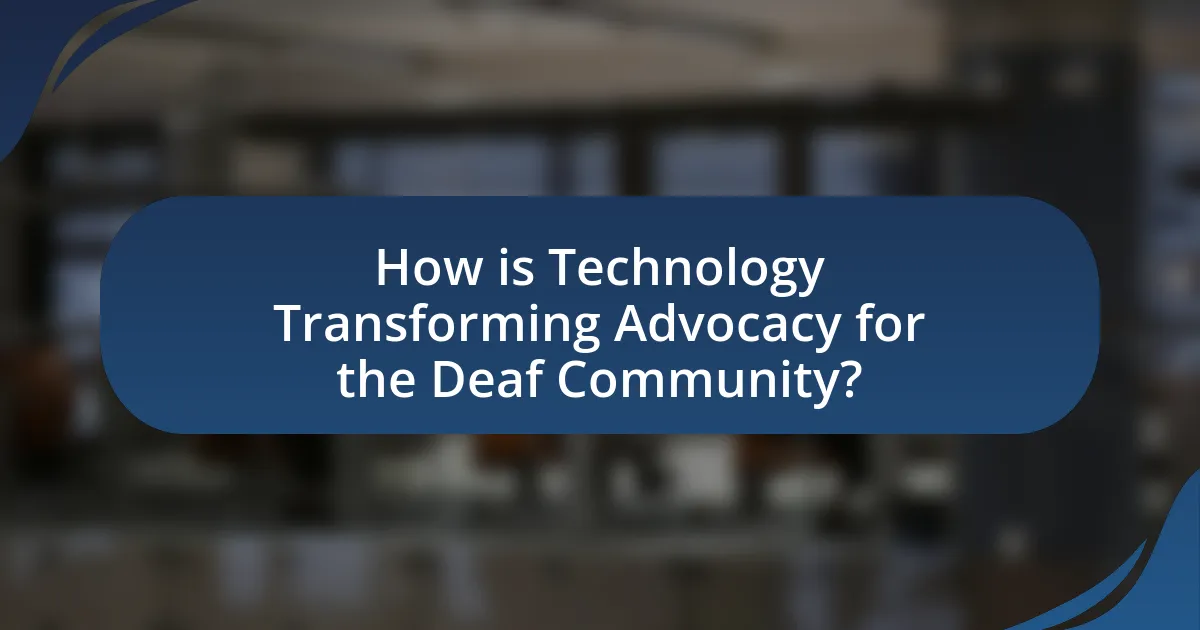
How is Technology Transforming Advocacy for the Deaf Community?
Technology is transforming advocacy for the Deaf community by enhancing communication access and increasing visibility of Deaf issues. Innovations such as video relay services (VRS) and real-time captioning enable Deaf individuals to communicate effectively with hearing individuals, thereby fostering inclusion in various settings, including workplaces and educational institutions. Additionally, social media platforms amplify Deaf voices and raise awareness about their rights and challenges, as evidenced by campaigns like #DeafTalent, which advocate for representation in media and entertainment. Furthermore, mobile applications designed for sign language learning and Deaf culture education empower both Deaf and hearing individuals to engage more meaningfully, promoting a more inclusive society.
What role does technology play in enhancing communication for the Deaf community?
Technology plays a crucial role in enhancing communication for the Deaf community by providing tools that facilitate real-time interaction and access to information. Innovations such as video relay services (VRS) allow Deaf individuals to communicate with hearing people through sign language interpreters via video calls, significantly improving accessibility. Additionally, text messaging and instant messaging applications enable seamless communication without the need for voice, while captioning services for videos and live events ensure that Deaf individuals can access spoken content. According to a study by the National Institute on Deafness and Other Communication Disorders, the use of technology has led to increased social engagement and improved educational outcomes for Deaf individuals, demonstrating its effectiveness in bridging communication gaps.
How do video relay services improve accessibility for Deaf individuals?
Video relay services (VRS) improve accessibility for Deaf individuals by enabling them to communicate in real-time with hearing individuals through a sign language interpreter via video technology. This service allows Deaf users to use their native sign language, facilitating more natural and effective communication compared to traditional text-based methods. According to the Federal Communications Commission, VRS has significantly increased the ability of Deaf individuals to engage in everyday conversations, access emergency services, and participate in professional environments, thereby enhancing their overall quality of life and inclusion in society.
What impact do mobile applications have on daily communication for the Deaf?
Mobile applications significantly enhance daily communication for the Deaf by providing accessible platforms for interaction. These applications, such as video relay services and instant messaging tools, enable Deaf individuals to communicate in real-time using sign language or text, bridging the gap created by traditional voice-based communication methods. Research indicates that 90% of Deaf individuals use smartphones, which facilitates their ability to connect with others, access information, and engage in social activities more effectively. This increased connectivity fosters a sense of community and belonging, essential for advocacy and support within the Deaf community.
Why is technology essential for advocacy within the Deaf community?
Technology is essential for advocacy within the Deaf community because it enhances communication, accessibility, and awareness. Communication tools such as video relay services and instant messaging platforms enable Deaf individuals to connect with hearing people and each other more effectively. Accessibility features, including captioning and sign language interpretation in digital media, ensure that Deaf individuals can access information and participate in discussions. Furthermore, social media platforms amplify advocacy efforts by raising awareness about Deaf culture and issues, mobilizing support, and fostering community engagement. For instance, the use of hashtags related to Deaf rights on platforms like Twitter has led to increased visibility and support for legislative changes, demonstrating the tangible impact of technology on advocacy.
How does technology facilitate awareness and education about Deaf culture?
Technology facilitates awareness and education about Deaf culture by providing accessible platforms for communication and information sharing. Social media, websites, and video-sharing platforms enable Deaf individuals and advocates to disseminate cultural content, share personal stories, and promote events, thereby increasing visibility and understanding of Deaf culture. For instance, platforms like YouTube host a variety of educational videos in sign language, which help bridge the gap between Deaf and hearing communities. Additionally, online courses and webinars offer structured learning opportunities about Deaf history, language, and rights, enhancing knowledge and fostering empathy. Research indicates that increased online engagement correlates with greater awareness and acceptance of Deaf culture in society, demonstrating technology’s pivotal role in advocacy efforts.
What are the challenges faced by advocates in utilizing technology?
Advocates face several challenges in utilizing technology, including accessibility issues, digital literacy gaps, and the rapid pace of technological change. Accessibility issues arise when technology is not designed with the needs of the deaf community in mind, leading to barriers in communication and information access. Digital literacy gaps can hinder advocates’ ability to effectively use technology, as not all individuals possess the necessary skills to navigate digital tools. Additionally, the rapid pace of technological change can make it difficult for advocates to stay updated on the latest tools and platforms, potentially limiting their effectiveness in advocacy efforts.
What advancements in technology are most beneficial for the Deaf community?
Advancements in technology that are most beneficial for the Deaf community include video relay services (VRS), real-time text (RTT), and mobile applications designed for communication. Video relay services allow Deaf individuals to communicate with hearing people through a sign language interpreter via video, enhancing accessibility and interaction. Real-time text enables text communication to be sent instantly as it is typed, facilitating smoother conversations. Additionally, mobile applications like Glide and Sorenson’s ZVRS provide platforms for video calls and messaging, further bridging communication gaps. These technologies have significantly improved social interaction and access to services for the Deaf community, as evidenced by increased usage statistics and user satisfaction surveys.
How do assistive listening devices enhance participation in public spaces?
Assistive listening devices enhance participation in public spaces by improving sound clarity and reducing background noise for individuals with hearing impairments. These devices, such as hearing aids and FM systems, amplify specific sounds, making it easier for users to engage in conversations and follow presentations in environments like theaters, classrooms, and public events. Research indicates that users of assistive listening devices report increased satisfaction and involvement in social activities, as they can better access auditory information. For instance, a study published in the Journal of the American Academy of Audiology found that 80% of participants using assistive listening technology experienced improved communication in group settings, demonstrating their effectiveness in fostering inclusion and active participation.
What innovations in social media are empowering Deaf voices?
Innovations in social media empowering Deaf voices include the integration of video content, real-time captioning, and sign language recognition technology. These advancements allow Deaf individuals to communicate more effectively and share their experiences widely. For instance, platforms like TikTok and Instagram support video formats that enable users to express themselves through sign language, fostering a sense of community and visibility. Additionally, tools such as automatic captioning on platforms like Facebook Live and YouTube enhance accessibility, ensuring that Deaf users can engage with content in real-time. Research indicates that these features significantly increase participation and representation of Deaf voices in online discussions, thereby transforming advocacy efforts within the Deaf community.
How can technology bridge gaps between the Deaf community and hearing individuals?
Technology can bridge gaps between the Deaf community and hearing individuals by facilitating communication through tools such as video relay services, real-time captioning, and mobile applications. These technologies enable Deaf individuals to engage in conversations with hearing people more effectively, reducing misunderstandings and fostering inclusivity. For instance, video relay services allow Deaf users to communicate via sign language interpreters, while real-time captioning provides immediate text translations of spoken dialogue, enhancing accessibility in various settings. Studies have shown that the use of such technologies significantly improves social interactions and access to information for Deaf individuals, thereby promoting equal participation in society.
What are the implications of technology on policy advocacy for the Deaf community?
Technology significantly enhances policy advocacy for the Deaf community by improving communication, access to information, and mobilization efforts. Digital platforms enable Deaf advocates to share their experiences and needs more effectively, fostering greater awareness among policymakers. For instance, video conferencing tools and social media allow for real-time engagement and collaboration, which can lead to more inclusive policy discussions. Additionally, the use of accessible online resources ensures that Deaf individuals can participate in advocacy efforts, as seen in campaigns that utilize captioned videos and sign language interpretation. These technological advancements not only amplify the voices of the Deaf community but also facilitate the dissemination of critical information, ultimately influencing policy changes that address their unique challenges.
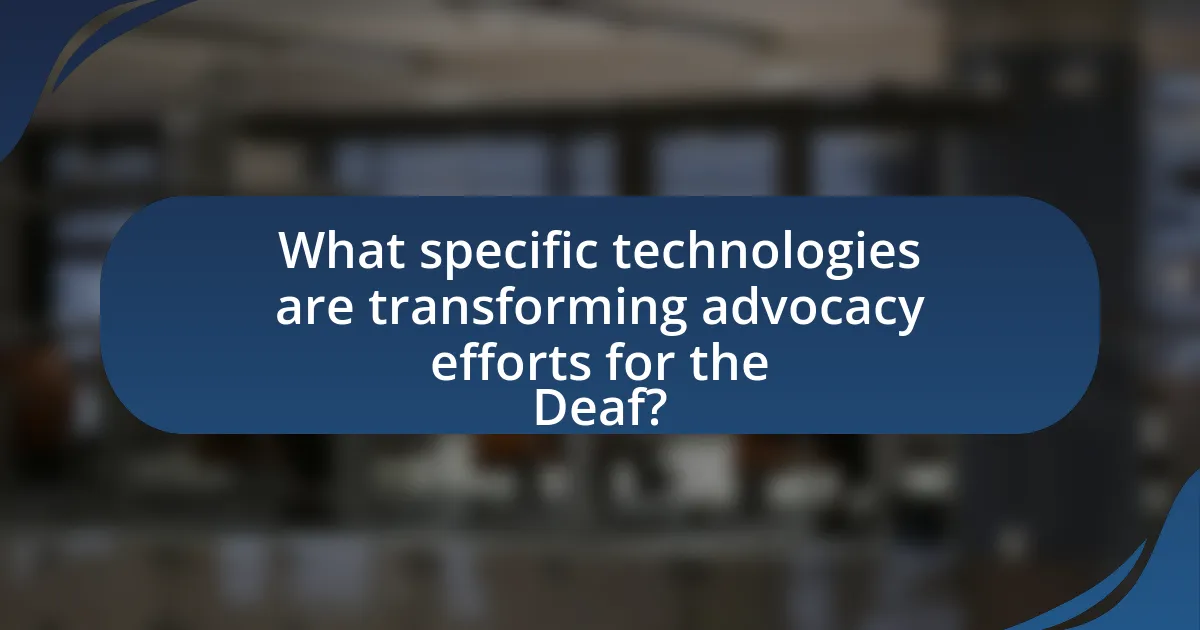
What specific technologies are transforming advocacy efforts for the Deaf?
Specific technologies transforming advocacy efforts for the Deaf include video relay services (VRS), real-time text (RTT), and mobile applications designed for communication. Video relay services enable Deaf individuals to communicate with hearing people through a sign language interpreter via video, enhancing accessibility and interaction. Real-time text allows for instant text communication during phone calls, facilitating smoother conversations. Additionally, mobile applications like Glide and Sorenson’s ZVRS provide platforms for video messaging and interpreting services, further empowering the Deaf community. These technologies collectively improve communication, increase awareness, and foster greater inclusion in society.
How are captioning services evolving to support Deaf advocacy?
Captioning services are evolving to support Deaf advocacy by incorporating real-time captioning, improved accuracy through AI technology, and enhanced accessibility features. These advancements allow for immediate and precise transcription of spoken content, which is crucial for Deaf individuals to engage fully in various environments, such as educational settings and public events. For instance, the use of AI-driven captioning tools has significantly increased the speed and reliability of captions, with studies showing that AI can achieve over 90% accuracy in real-time scenarios. Additionally, platforms are now integrating customizable captioning options, enabling users to adjust text size, color, and background, which further promotes inclusivity and user preference. These developments not only enhance communication access but also empower the Deaf community by ensuring their voices are represented and heard in diverse contexts.
What types of captioning technologies are available today?
There are several types of captioning technologies available today, including real-time captioning, closed captioning, open captioning, and automatic speech recognition (ASR) captioning. Real-time captioning, often used in live broadcasts and events, provides immediate text representation of spoken words, enhancing accessibility for deaf and hard-of-hearing individuals. Closed captioning allows viewers to toggle captions on or off, while open captioning displays text permanently on the screen. ASR captioning utilizes advanced algorithms to transcribe spoken language into text automatically, making it a cost-effective solution for various media formats. These technologies collectively improve communication access and inclusivity for the deaf community.
How do real-time captioning services impact accessibility in events?
Real-time captioning services significantly enhance accessibility in events by providing immediate text representation of spoken content, allowing individuals who are deaf or hard of hearing to fully engage with the material being presented. These services ensure that participants can follow along with discussions, presentations, and performances in real-time, thereby promoting inclusivity and equal access to information. Research indicates that events utilizing real-time captioning see increased participation from attendees with hearing impairments, as they can comprehend and interact with the content without barriers. For instance, a study published in the Journal of Accessibility and Design for All found that 85% of participants reported improved understanding of event content when real-time captioning was available, highlighting its critical role in fostering an inclusive environment.
What role do online platforms play in Deaf advocacy?
Online platforms play a crucial role in Deaf advocacy by providing accessible communication channels and amplifying the voices of the Deaf community. These platforms facilitate the sharing of information, resources, and experiences, enabling Deaf individuals to connect, organize, and advocate for their rights. For instance, social media networks like Facebook and Twitter allow Deaf advocates to raise awareness about issues such as accessibility and discrimination, reaching a wider audience and fostering community support. Additionally, video-sharing platforms like YouTube enable the creation and dissemination of content in sign language, making advocacy messages more accessible to Deaf individuals. Research indicates that online engagement has significantly increased visibility for Deaf issues, with campaigns like #DeafTalent gaining traction and influencing public perception.
How do webinars and online workshops enhance advocacy training?
Webinars and online workshops enhance advocacy training by providing accessible, interactive platforms for learning and engagement. These digital formats allow participants to connect with experts and peers regardless of geographical barriers, facilitating the sharing of knowledge and best practices in advocacy. For instance, a study by the Pew Research Center found that 73% of adults prefer online learning due to its convenience and flexibility, which is particularly beneficial for individuals in the Deaf community who may face mobility challenges. Additionally, webinars often incorporate real-time feedback and Q&A sessions, fostering a collaborative learning environment that can lead to more effective advocacy strategies.
What are the benefits of virtual communities for Deaf individuals?
Virtual communities provide Deaf individuals with enhanced social interaction, access to resources, and opportunities for advocacy. These online platforms facilitate connections among Deaf individuals, allowing them to share experiences and support each other, which is crucial for mental well-being. Research indicates that participation in virtual communities can lead to increased feelings of belonging and reduced isolation, as evidenced by a study published in the Journal of Deaf Studies and Deaf Education, which found that online interactions significantly improve social engagement among Deaf individuals. Additionally, virtual communities serve as a space for advocacy, enabling Deaf individuals to mobilize around issues affecting their rights and access to services, thereby amplifying their voices in broader societal discussions.
How is artificial intelligence influencing advocacy for the Deaf community?
Artificial intelligence is significantly influencing advocacy for the Deaf community by enhancing communication accessibility and promoting awareness. AI technologies, such as real-time speech-to-text transcription and automated sign language interpretation, facilitate better interaction between Deaf individuals and hearing people, thereby reducing communication barriers. For instance, applications like Ava and Google Live Transcribe utilize AI to convert spoken language into text instantly, allowing Deaf users to participate more fully in conversations and public events. Additionally, AI-driven platforms are being used to analyze social media trends and public sentiment, enabling advocacy organizations to tailor their campaigns effectively and address the specific needs of the Deaf community. This integration of AI not only empowers Deaf individuals but also fosters a more inclusive society by raising awareness about Deaf culture and issues.
What are the applications of AI in improving communication for the Deaf?
AI applications in improving communication for the Deaf include real-time speech-to-text transcription, sign language recognition, and automated captioning. Real-time speech-to-text transcription tools, such as Google’s Live Transcribe, convert spoken language into written text instantly, facilitating conversations. Sign language recognition systems, like those developed by researchers at the University of Cambridge, utilize machine learning to interpret sign language gestures and translate them into spoken or written language. Automated captioning services, employed in platforms like YouTube and Zoom, provide instant captions for videos and live events, enhancing accessibility. These technologies collectively enhance communication, making interactions more inclusive for the Deaf community.
How can AI-driven tools assist in advocacy campaigns?
AI-driven tools can significantly enhance advocacy campaigns by providing data analysis, targeted outreach, and personalized communication strategies. These tools analyze large datasets to identify trends and sentiments within the deaf community, enabling advocates to tailor their messages effectively. For instance, AI algorithms can process social media interactions to gauge public opinion on specific issues affecting the deaf community, allowing campaigns to adapt in real-time. Additionally, AI can automate outreach efforts, ensuring that messages reach the right audiences through optimal channels, which increases engagement rates. Research from the Pew Research Center indicates that targeted messaging can improve campaign effectiveness by up to 50%, demonstrating the tangible benefits of utilizing AI in advocacy efforts.
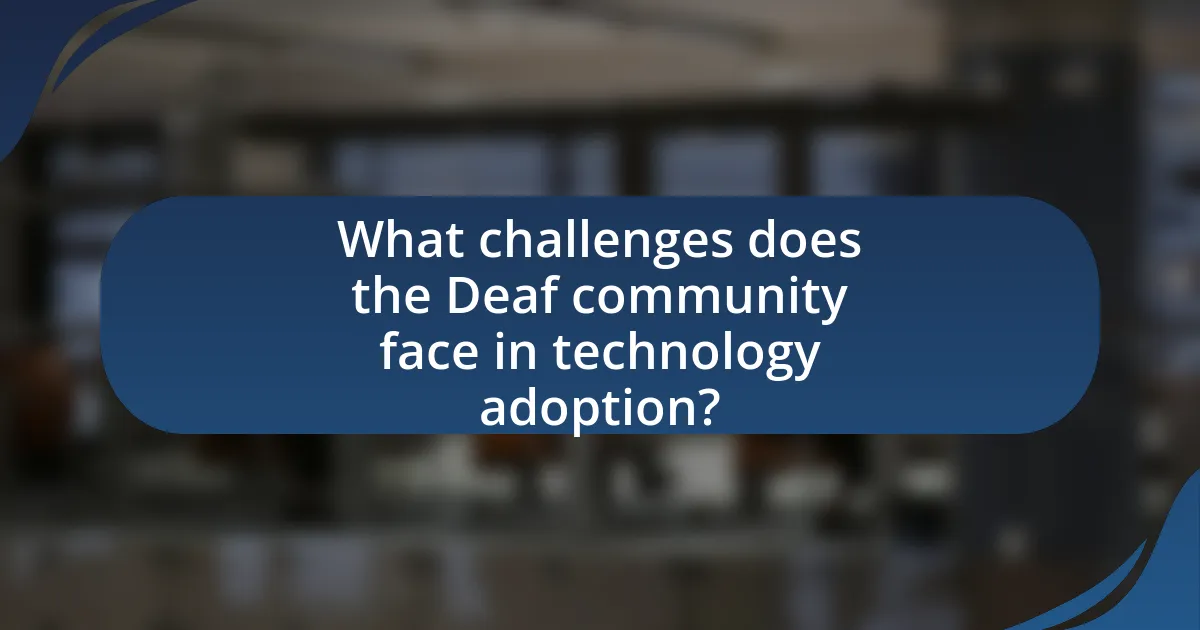
What challenges does the Deaf community face in technology adoption?
The Deaf community faces significant challenges in technology adoption, primarily due to accessibility issues, lack of awareness, and inadequate support. Accessibility issues arise when technology does not incorporate features like captions or sign language interpretation, making it difficult for Deaf individuals to engage fully. For instance, a study by the National Association of the Deaf highlights that many video conferencing platforms lack real-time captioning, which limits participation in professional and social settings. Additionally, there is often a lack of awareness among technology developers about the specific needs of the Deaf community, leading to products that do not cater to their requirements. Furthermore, inadequate support and training for using new technologies can hinder effective adoption, as many Deaf individuals may not receive proper guidance on how to utilize these tools effectively.
What barriers exist in accessing technology for Deaf individuals?
Barriers in accessing technology for Deaf individuals include inadequate accessibility features, lack of awareness among developers, and high costs of assistive devices. Many mainstream technologies do not incorporate features like captioning or sign language interpretation, limiting usability for Deaf users. Additionally, developers often lack understanding of Deaf culture and needs, resulting in products that do not cater to this community. Furthermore, the financial burden of specialized technology, such as video relay services or hearing aids, can be prohibitive, with costs sometimes exceeding thousands of dollars, making it difficult for many Deaf individuals to access essential tools for communication and information.
How does socioeconomic status affect technology access for the Deaf?
Socioeconomic status significantly affects technology access for the Deaf by influencing the availability of resources necessary for acquiring assistive technologies. Individuals from lower socioeconomic backgrounds often face financial barriers that limit their ability to purchase devices such as hearing aids, video relay services, and smartphones equipped with accessibility features. According to a study published in the Journal of Deaf Studies and Deaf Education, individuals with higher income levels are more likely to access advanced communication technologies, which enhances their ability to engage in social and professional environments. This disparity in access can lead to increased isolation and reduced opportunities for education and employment among Deaf individuals from lower socioeconomic backgrounds.
What role does education play in technology adoption among the Deaf?
Education significantly influences technology adoption among the Deaf by equipping individuals with the necessary skills and knowledge to utilize technological tools effectively. Research indicates that Deaf individuals who receive education that incorporates technology are more likely to adopt and integrate these tools into their daily lives. For instance, studies show that Deaf students exposed to technology in educational settings demonstrate higher proficiency in using communication devices and software, which enhances their ability to engage with both the Deaf and hearing communities. Furthermore, educational programs that focus on digital literacy specifically for the Deaf have been shown to improve access to information and resources, thereby facilitating greater technology adoption.
How can advocates overcome these challenges?
Advocates can overcome challenges by leveraging technology to enhance communication and accessibility for the Deaf community. Utilizing video relay services and real-time captioning tools allows advocates to effectively convey messages and engage with a broader audience. Research indicates that the use of mobile applications specifically designed for Deaf individuals has increased access to resources and support networks, thereby empowering advocates to address issues more efficiently. For instance, the National Association of the Deaf reports that technology-driven initiatives have significantly improved advocacy efforts by providing platforms for collaboration and information sharing among stakeholders.
What strategies can be implemented to improve technology access?
To improve technology access for the Deaf community, implementing strategies such as increasing funding for accessible technology initiatives, enhancing digital literacy programs, and promoting partnerships between tech companies and advocacy organizations is essential. Increased funding can support the development of specialized tools like video relay services and captioning software, which are crucial for effective communication. Digital literacy programs can empower individuals by teaching them how to use technology effectively, ensuring they can access resources and services. Collaborations between tech companies and advocacy groups can lead to the creation of more inclusive products that cater specifically to the needs of the Deaf community, thereby enhancing overall access to technology.
How can community organizations support Deaf individuals in technology use?
Community organizations can support Deaf individuals in technology use by providing accessible training programs tailored to their specific needs. These organizations can facilitate workshops that focus on using assistive technologies, such as video relay services and captioning software, which enhance communication access. Research indicates that access to technology training significantly improves the digital literacy of Deaf individuals, enabling them to engage more fully in society. For example, a study by the National Deaf Center on Postsecondary Outcomes found that Deaf students who received technology training were more likely to succeed in academic and professional settings.
What best practices should advocates follow when using technology?
Advocates should prioritize accessibility, data privacy, and effective communication when using technology. Ensuring that all digital platforms and tools are accessible to individuals with hearing impairments is crucial; this includes using captioning, sign language interpretation, and user-friendly interfaces. Data privacy must be maintained to protect sensitive information, as advocates often handle personal data of community members. Furthermore, effective communication through social media, websites, and apps can enhance outreach and engagement, allowing advocates to connect with a broader audience. Research indicates that accessible technology increases participation rates among the deaf community, demonstrating the importance of these best practices in advocacy efforts.
How can advocates ensure inclusivity in technology-driven initiatives?
Advocates can ensure inclusivity in technology-driven initiatives by actively involving diverse stakeholders from the deaf community in the design and implementation processes. This approach allows for the identification of specific needs and preferences, ensuring that technology solutions are accessible and relevant. Research indicates that inclusive design practices lead to better user experiences; for instance, a study by the World Health Organization highlights that involving users with disabilities in the development of assistive technologies significantly improves their effectiveness and adoption rates. By prioritizing user feedback and collaboration, advocates can create technology initiatives that genuinely serve the deaf community’s needs.
What resources are available for training advocates in technology use?
Resources available for training advocates in technology use include online courses, workshops, and specialized training programs. Organizations such as the National Association of the Deaf (NAD) offer resources and training materials focused on technology advocacy for the deaf community. Additionally, platforms like Coursera and edX provide courses on digital literacy and assistive technology, which are essential for advocates. Research indicates that training programs significantly enhance the effectiveness of advocates in utilizing technology to support the deaf community, as evidenced by increased engagement and improved communication outcomes.
